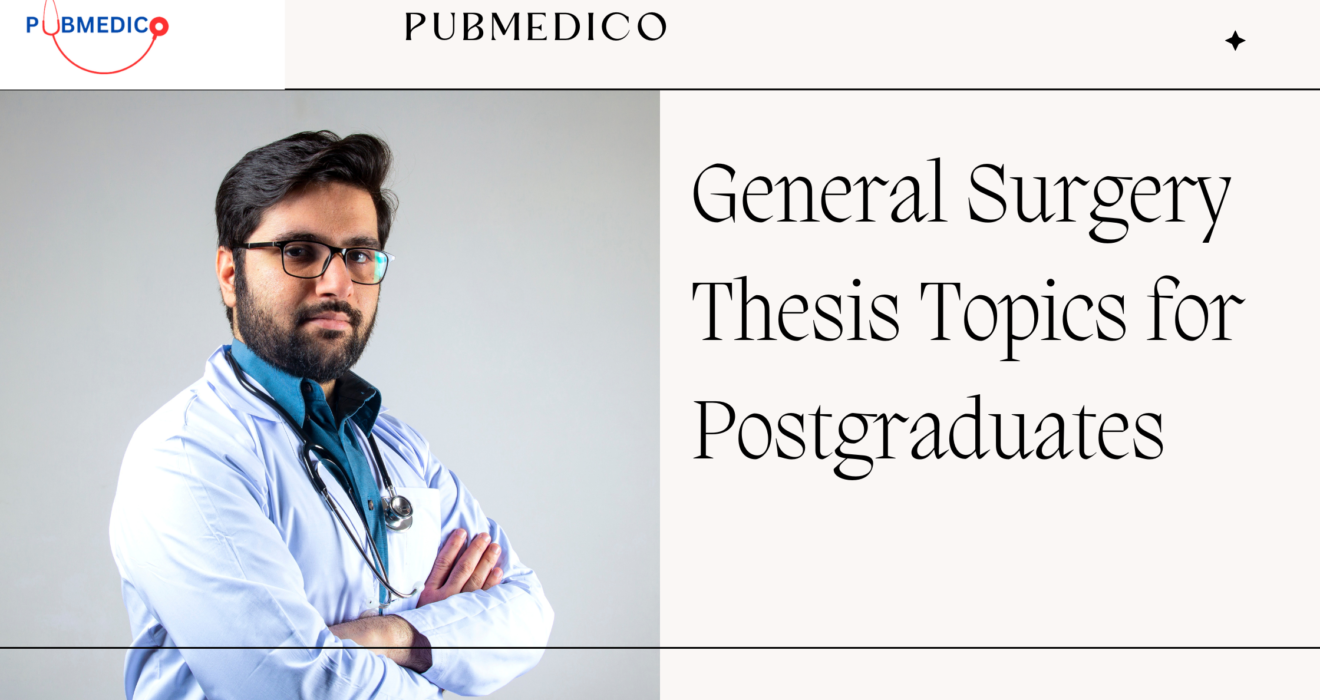General Surgery Thesis Topics for Postgraduates
 General Surgery Thesis Topics for Postgraduates
General Surgery Thesis Topics for Postgraduates
Choosing a thesis topic in general surgery can feel like finding a needle in a haystack. The pressure to contribute something meaningful while keeping it researchable is real! Don’t worry, though. Whether you’re looking for innovation, relevance, or simply inspiration, I’ve compiled a goldmine of general surgery thesis topics just for you.
This blog covers 100+ trending topics, tips to help you choose the perfect one, and key areas of interest in general surgery. So, let’s dive into the world of groundbreaking ideas!
Why Choosing the Right Thesis Topic Matters?
Your thesis is more than just a mandatory part of your postgraduate degree—it’s a gateway to advancing your knowledge and contributing to the medical community. The right topic can:
- Set the stage for your career.
- Showcase your expertise in a niche field.
- Spark innovations in patient care.
So, whether you’re passionate about minimally invasive techniques or fascinated by surgical oncology, picking the right topic is critical.
100+ General Surgery Thesis Topics
Here’s a curated list of postgraduate general surgery thesis topics, divided by sub-specialty areas:
1. Gastrointestinal Surgery:
- Evaluation of Hyperbilirubinemia as a Diagnostic Marker for Gangrenous or Perforated Appendicitis: Investigate the correlation between elevated bilirubin levels and complicated appendicitis cases.
- Comparative Study of Laparoscopic Versus Open Cholecystectomy in Symptomatic Gallstone Disease: Assess patient outcomes, recovery times, and complication rates between these two surgical approaches.
- A Prospective Clinical Study of Acute Intestinal Obstruction: Analyze the causes, management strategies, and patient outcomes in cases of acute intestinal obstruction.
- Management Strategies and Outcomes in Duodenal Perforation: Evaluate different treatment protocols and their effectiveness in patient recovery.
- Clinical Study on Gastrointestinal Perforation: Investigate the etiology, presentation, and surgical management of gastrointestinal perforations.
- Comparative Study of Laparoscopic and Open Appendectomy for Acute Appendicitis: Assess the benefits and drawbacks of each surgical method in terms of recovery and complications.
- Role of Diagnostic Laparoscopy in Acute Abdominal Conditions: Evaluate the effectiveness of laparoscopy in diagnosing and managing acute abdominal emergencies.
- Outcomes of Surgical Management in Patients with Obstructive Jaundice: Analyze the success rates and complications associated with different surgical interventions.
- Efficacy of Early Versus Delayed Feeding Post-Gastrointestinal Surgery: Investigate the impact of feeding timing on patient recovery and complication rates.
- Assessment of Surgical Site Infections in Gastrointestinal Surgeries: Identify risk factors and preventive measures to reduce postoperative infections.
 contact us click on that for email inquary mailto:researchnnnn@gmail.com?subject=i%20need%20help%20in%20my%20thesis&body=i%20need%20help%20in%20my%20thesis%20submission%20
contact us click on that for email inquary mailto:researchnnnn@gmail.com?subject=i%20need%20help%20in%20my%20thesis&body=i%20need%20help%20in%20my%20thesis%20submission%20
2. Hernia Repair:
- Preservation Versus Division of Ilioinguinal and Iliohypogastric Nerves During Lichtenstein Hernioplasty: Examine postoperative pain and recurrence rates associated with each technique.
- Day Care Surgery Feasibility in Uncomplicated Inguinal Hernia Repair: Evaluate the safety and effectiveness of same-day discharge protocols for hernia patients.
- Comparative Study of Anatomical Repair and Lichtenstein Repair for Inguinal Hernia: Assess the outcomes and recurrence rates between these two surgical methods.
- Clinical Study and Management of Umbilical and Paraumbilical Hernia in Adults: Investigate the presentation, treatment options, and patient outcomes.
- Evaluation of Laparoscopic Versus Open Repair for Ventral Hernias: Compare recovery times, complications, and recurrence rates between the two approaches.
- Efficacy of Mesh Repair in Incisional Hernias: Analyze patient outcomes and recurrence rates following mesh implantation.
- Assessment of Chronic Pain Following Inguinal Hernia Repair: Identify factors contributing to postoperative pain and strategies to mitigate it.
- Outcomes of Emergency Versus Elective Hernia Repairs: Compare patient recovery and complication rates in different surgical settings.
- Role of Imaging in Diagnosing Recurrent Hernias Post-Repair: Evaluate the effectiveness of various imaging modalities in detecting recurrences.
- Impact of Obesity on Hernia Repair Outcomes: Investigate how body mass index influences surgical success and complications.
contact us click on that for email inquary mailto:researchnnnn@gmail.com?subject=i%20need%20help%20in%20my%20thesis&body=i%20need%20help%20in%20my%20thesis%20submission%20
3. Breast Surgery:
- Role of Centchroman in the Management of Mastalgia and Fibroadenoma: Conduct a randomized study to determine the efficacy of this non-steroidal medication in treating benign breast conditions
- Quality of Life and Rehabilitation Needs in Breast Cancer Survivors: Assess the long-term physical and psychological outcomes post-surgery.
- Comparative Study of Breast-Conserving Surgery Versus Mastectomy in Early-Stage Breast Cancer: Evaluate patient outcomes, recurrence rates, and quality of life.
- Efficacy of Sentinel Lymph Node Biopsy in Predicting Axillary Nodal Status Post-Neoadjuvant Chemotherapy: Investigate the accuracy of sentinel node biopsy in staging breast cancer after chemotherapy.
- Assessment of Postoperative Complications Following Breast Reconstruction: Analyze the incidence and types of complications in reconstructive surgeries.
- Impact of Neoadjuvant Chemotherapy on Surgical Outcomes in Locally Advanced Breast Cancer: Evaluate how preoperative chemotherapy influences surgical decisions and patient recovery.
- Role of Imaging Modalities in the Early Detection of Breast Cancer Recurrence: Compare the effectiveness of various imaging techniques in monitoring for recurrence.
- Patient Satisfaction and Aesthetic Outcomes Following Different Breast Reconstruction Techniques: Assess subjective and objective outcomes of various reconstructive methods.
- Management Strategies for Male Breast Cancer: Investigate the presentation, treatment options, and outcomes in male patients.
- Efficacy of Intraoperative Radiotherapy in Early Breast Cancer: Evaluate the benefits and potential risks associated with single-dose radiotherapy during surgery.
 contact us click on that for email inquary mailto:researchnnnn@gmail.com?subject=i%20need%20help%20in%20my%20thesis&body=i%20need%20help%20in%20my%20thesis%20submission%20
contact us click on that for email inquary mailto:researchnnnn@gmail.com?subject=i%20need%20help%20in%20my%20thesis&body=i%20need%20help%20in%20my%20thesis%20submission%20
4. Thyroid Surgery:
- Diagnostic Modalities in the Assessment and Management of Solitary Thyroid Nodules: Compare the accuracy of ultrasound, fine-needle aspiration, and other imaging techniques in diagnosing thyroid nodules.
- Correlation Between Serum TSH Levels and Thyroid Vascularity Observed During Surgery: Investigate how preoperative thyroid-stimulating hormone levels relate to intraoperative findings.
- Incidence of Malignancy in Multinodular Goiters: Analyze the prevalence of cancerous nodules in patients undergoing surgery for multinodular goiter.
- Efficacy of Fine Needle Aspiration Cytology in Diagnosing Solitary Thyroid Nodules: Evaluate the sensitivity and specificity of FNAC in preoperative assessment.
- Outcomes of Total Versus Subtotal Thyroidectomy in Benign Thyroid Diseases: Compare complication rates and recurrence in different surgical extents.
- Assessment of Postoperative Hypocalcemia Following Thyroid Surgery: Identify risk factors and preventive measures for hypocalcemia after thyroidectomy.
contact us click on that for email inquary mailto:researchnnnn@gmail.com?subject=i%20need%20help%20in%20my%20thesis&body=i%20need%20help%20in%20my%20thesis%20submission%20
5. Trauma Surgery:
- Focused Assessment with Sonography for Trauma (FAST) in Blunt Abdominal Trauma: Conduct a prospective study to evaluate the diagnostic accuracy of FAST exams in emergency settings.
- Management Strategies and Outcomes in Blunt Abdominal Trauma: Analyze different treatment protocols and their effectiveness in patient recovery.
- Comparative Study of Non-Operative Versus Operative Management in Penetrating Abdominal Injuries: Assess patient outcomes, complications, and recovery times between the two approaches.
- Evaluation of Trauma Scoring Systems in Predicting Patient Outcomes: Compare the effectiveness of different scoring systems like RTS and GAP in trauma care.
- Role of Damage Control Surgery in Severe Trauma Cases: Investigate the efficacy and outcomes of staged surgical interventions in critically injured patients.
- Incidence and Management of Traumatic Diaphragmatic Injuries: Study the presentation, diagnosis, and treatment outcomes of diaphragmatic injuries due to trauma.
- Outcomes of Early Versus Delayed Surgical Intervention in Traumatic Brain Injuries: Analyze the impact of timing on patient recovery and survival rates.
- Assessment of Complications Following Splenic Injuries Managed Non-Operatively: Evaluate the risks and benefits associated with conservative management of splenic trauma.
- Impact of Pre-Hospital Care on Trauma Patient Outcomes: Examine how initial management by emergency services influences overall recovery.
- Efficacy of Tranexamic Acid in Reducing Mortality in Trauma Patients: Conduct a randomized controlled trial to assess the benefits of antifibrinolytic therapy in acute trauma care.
contact us click on that for email inquary mailto:researchnnnn@gmail.com?subject=i%20need%20help%20in%20my%20thesis&body=i%20need%20help%20in%20my%20thesis%20submission%20
6. Minimally Invasive Surgery:
- Three-Port Versus Four-Port Laparoscopic Cholecystectomy: Perform a randomized controlled study comparing operative times, complications, and patient satisfaction between the two techniques.
- Efficacy of Low-Pressure Versus Standard-Pressure Pneumoperitoneum in Laparoscopic Procedures: Assess postoperative pain and recovery associated with different insufflation pressures.
- Outcomes of Single-Incision Laparoscopic Surgery Compared to Conventional Multi-Port Techniques: Evaluate cosmetic results, patient satisfaction, and complication rates.
- Role of Robotic Assistance in Complex Abdominal Surgeries: Analyze the benefits and limitations of robotic systems in minimally invasive procedures.
- Comparison of Laparoscopic Versus Open Inguinal Hernia Repair in Terms of Chronic Pain: Investigate long-term pain outcomes between the two surgical methods.
- Efficacy of Laparoscopic Sleeve Gastrectomy in Morbidly Obese Patients: Assess weight loss outcomes and complication rates in bariatric surgery.
- Impact of Surgeon Experience on Outcomes in Laparoscopic Colorectal Surgeries: Study how the learning curve affects patient results and complication rates.
- Assessment of Postoperative Adhesion Formation After Laparoscopic Versus Open Surgery: Compare the incidence of adhesions between minimally invasive and traditional approaches.
- Cost-Effectiveness Analysis of Laparoscopic Versus Open Appendectomy: Evaluate the economic implications and patient outcomes associated with each technique.
- Patient Recovery and Satisfaction Following Laparoscopic Fundoplication for GERD: Investigate the effectiveness and patient perspectives on minimally invasive treatment for gastroesophageal reflux disease.

contact us click on that for email inquary mailto:researchnnnn@gmail.com?subject=i%20need%20help%20in%20my%20thesis&body=i%20need%20help%20in%20my%20thesis%20submission%20
7. Vascular Surgery:
- Management of Lower Limb Varicose Veins Based on CEAP Classification: Compare conservative and surgical treatments in terms of patient outcomes and recurrence rates.
- Efficacy of Endovenous Laser Therapy Versus Traditional Vein Stripping in Varicose Veins: Assess patient recovery, satisfaction, and recurrence rates between the two methods.
- Outcomes of Carotid Endarterectomy Versus Carotid Artery Stenting in Patients with Carotid Stenosis: Compare the efficacy and complication rates of both interventions.
- Role of Antiplatelet Therapy in Preventing Graft Occlusion After Peripheral Bypass Surgery: Investigate the effectiveness of antiplatelet medications in maintaining graft patency.
- Assessment of Abdominal Aortic Aneurysm Screening Programs in Reducing Mortality: Evaluate the impact of screening on early detection and patient survival rates.
- Comparison of Open Versus Endovascular Repair of Thoracic Aortic Aneurysms: Analyze patient outcomes, recovery times, and complication rates between the two approaches.
- Efficacy of Compression Therapy in the Management of Chronic Venous Insufficiency: Assess the benefits and patient compliance associated with compression treatments.
- Outcomes of Surgical Versus Non-Surgical Management of Acute Limb Ischemia: Compare the effectiveness and complications of different treatment strategies.
- Impact of Smoking Cessation on Postoperative Complications in Vascular Surgery Patients: Investigate how quitting smoking influences recovery and complication rates.
- Assessment of Quality of Life in Patients Undergoing Lower Extremity Amputation for Vascular Disease: Evaluate the physical and psychological outcomes following amputation.




